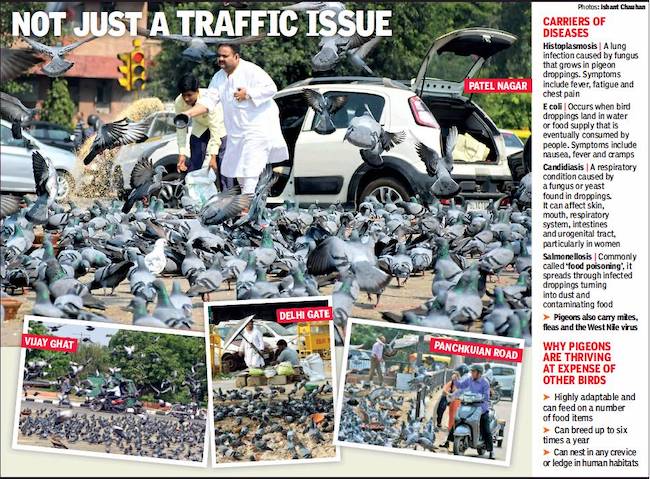Pigeons: India
This is a collection of articles archived for the excellence of their content. |
Feeding pigeons
The consequences
Jasjeev Gandhiok & Paras Singh, Oct 14, 2019: The Times of India

From: Jasjeev Gandhiok & Paras Singh, Oct 14, 2019: The Times of India
For years untold, the common pigeon — also known as blue rock pigeon — has been seen as a symbol of love. And while feeding them at traffic islands may be some people’s way of seeking a staircase to heaven, the practice has become a major safety hazard in more ways than one.
Last week, a woman was killed and her husband and daughter injured on Lajpat Nagar flyover when their scooter was hit by a BSF bus while they were overtaking a parked car whose driver had stopped there to feed pigeons. The incident illustrated how the flock of birds at these islands not only causes a nuisance, but also poses a threat to bikers who try to manoeuvre their way to avoid being hit by them. People stopping by to feed these birds, too, risk their own lives in doing so. At places where railings and fences have been installed to stop this practice, seeds are still dropped from the sides, as TOI noticed when it visited some of these popular haunts.
Birders say this practice of feeding the pigeons is not only destroying their instinct to hunt, but also creating food security to help them breed. Their proliferation is to the detriment of other species, once common such as the house sparrow and the Brahminy mynah. To add to such worries of ornithologists, health experts also say that pigeon droppings and feathers are associated with respiratory disorders. “Similar to monkeys, pigeons have become a pest and this is bad news for other birds. At places where fences have been put, people are still feeding them. Diseases can easily spread to people without them even realising it,” said birder Nikhil Devasar.
“There are a lot of foraging points across the city that are helping pigeons grow in numbers,” said Faiyaz Khudsar, scientist in charge at Yamuna Biodiversity Park. “They can feed on many types of grain and are very flexible about nesting. They also congregate in many areas, which means there is less space available for sparrows or smaller birds to nest in.”
Khudsar added that people should realise that feeding pigeons did not guarantee them a spot in heaven, but actually left them at risk of respiratory disorders. “People regularly present in areas where pigeons feed can contract diseases through their droppings and feathers,” he said. Studies have that found bird droppings and feathers can lead to diseases, such as histoplasmosis, candidiasis and cryptococcosis, which can be fatal in some cases. The birds are also carriers of ectoparasites, including bed bugs and yellow mealworms. Pigeons are considered an invasive species. They are quick breeders, hatching chicks up to six times a year.
Zoologist Surya Prakash feels “human interference” has added to the problem of proliferation. “Not only are birds very adaptable, but they also need to find food. The fact that humans are providing the pigeons food is disturbing the natural balance,” said Prakash. The increase in pigeons has seen an accompanying depletion in sparrow populations. Devasar feels the pigeons’ capacity to adapt has allowed them to nest and breed in spaces where other birds cannot. “Be it under a window AC, in crevices or on shelves, pigeons can nest anywhere,” Devasar pointed out. “Therefore, they have easily taken over spaces where once only sparrows could be found. Naturally sparrows are now rare in urban areas.”
A senior public health official from south corporation acknowledged the challenge. “The Delhi Municipal Corporation Act grants us powers to act in case a certain animal population starts causing a public health crisis. With no check on them by other predatory birds, the pigeon population is assuming gigantic proportions. They can soon be categorised as urban bird pests,” an official said. He added: “Each pigeon is estimated to create 11.5kg of excreta every year. Since this excreta is acidic in nature, it damages buildings and monuments. It also spreads salmonella germs.”
When TOI contacted the corporations on the issue, officials said specialised posts and non-lethal methods could be used to control the pigeon count. “Earlier, control of animal causing diseases used to come under the public health department, but the task was later shifted to the veterinary department. We had specialised posts like red gang coolies who would keep a tab on rodent population, but over the years, such posts have been phased out,” an official said.
Another SDMC official suggested that department use non-chemical, non-lethal techniques like netting and trapping. “But the best way is to control the rampant feeding on the roadsides. Police should not allow these feeding islands to prosper,” the official said. A senior veterinary department official asserted that pigeons were covered under the Wildlife Protection Act, 1972, and managing such “wild animals” and their habitat was the mandate of forest departments and not the local bodies.